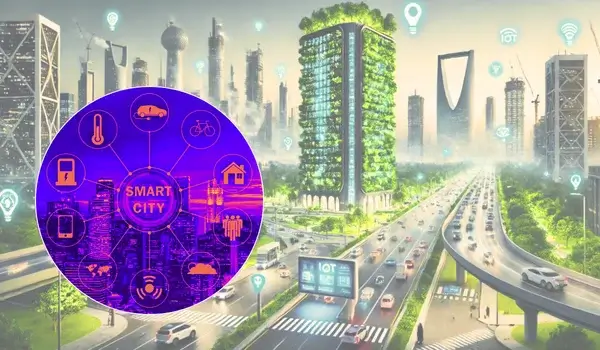Smart cities are urban areas that utilize advanced technologies such as the Internet of Things (IoT), artificial intelligence (AI), and data analytics to improve infrastructure, enhance public services, and optimize resource management. Designed to address the challenges of urbanization, smart cities aim to create a more efficient, sustainable, and livable environment for their residents. However, like any innovation, smart cities come with both advantages and disadvantages. This article explores the pros and cons of smart cities in detail.
What are Smart Cities?
A smart city integrates technology into its infrastructure and operations to enhance the quality of life for its residents. It leverages real-time data from interconnected devices and sensors to manage urban services, such as transportation, energy, water, and waste management, efficiently. Examples of smart city technologies include smart grids, autonomous vehicles, and intelligent public safety systems.

Advantages of Smart Cities
1. Enhanced Quality of Life
Smart cities improve living standards by providing efficient services, such as smart healthcare, intelligent traffic management, and enhanced public safety.
2. Efficient Resource Management
Smart city technologies optimize the use of resources like water, electricity, and energy, reducing waste and ensuring sustainable development.
3. Improved Transportation Systems
Smart traffic systems use real-time data to reduce congestion, optimize traffic flow, and improve public transportation efficiency.
4. Environmental Sustainability
Smart cities employ green technologies such as renewable energy sources, smart grids, and waste-to-energy systems to minimize environmental impact.
5. Economic Growth
The integration of technology fosters innovation and entrepreneurship, creating new job opportunities and boosting the local economy.
6. Better Public Safety
Advanced surveillance systems, predictive policing, and disaster management technologies enhance safety and security for residents.
7. Citizen Engagement
Digital platforms and apps allow residents to interact with city authorities, provide feedback, and access real-time information about public services.
8. Healthcare Advancements
Telemedicine, remote monitoring, and smart health records make healthcare more accessible and efficient, especially for aging populations.
9. Improved Governance
Smart cities enable data-driven decision-making, improving transparency, accountability, and service delivery by local governments.
10. Increased Connectivity
IoT-enabled devices and high-speed internet create a highly connected urban ecosystem, improving communication and access to services.
Disadvantages of Smart Cities
1. High Initial Costs
Developing a smart city requires substantial investment in infrastructure, technology, and human resources, which may strain public budgets.
2. Privacy Concerns
The extensive use of surveillance systems and data collection raises concerns about the privacy and security of citizens’ personal information.
3. Cybersecurity Risks
The reliance on interconnected systems makes smart cities vulnerable to cyberattacks, which could disrupt essential services.
4. Digital Divide
Unequal access to technology and internet connectivity can create a digital divide, excluding certain populations from the benefits of smart cities.
5. Complex Implementation
Integrating various technologies and systems into existing urban infrastructures is complex and requires significant coordination and expertise.
6. Dependence on Technology
Over-reliance on technology can make smart cities less resilient in the event of system failures or natural disasters.
7. Maintenance Challenges
The advanced technologies used in smart cities require regular maintenance and upgrades, increasing operational costs.
8. Potential Job Displacement
Automation and AI-driven processes may lead to job losses in traditional sectors, particularly for low-skilled workers.
9. Exclusion of Vulnerable Groups
Elderly and less tech-savvy individuals may struggle to adapt to the technological systems, leading to social exclusion.
10. Environmental Concerns from E-Waste
The rapid adoption of technology can lead to increased electronic waste (e-waste) if not managed responsibly.
Comparison Table: Benefits vs. Drawbacks
| Pros | Cons |
|---|---|
| Improved quality of life through smart services | High initial infrastructure costs |
| Efficient resource management | Privacy concerns due to data collection |
| Reduced traffic congestion and better transport | Cybersecurity risks from interconnected systems |
| Promotes environmental sustainability | Complex implementation and coordination |
| Fosters economic growth and innovation | Over-reliance on technology |
| Enhances public safety and disaster management | Maintenance and operational challenges |
| Encourages citizen engagement | Potential job displacement due to automation |
| Accessible healthcare through smart technologies | Exclusion of less tech-savvy populations |
| Transparent and data-driven governance | Risk of creating a digital divide |
| Increased connectivity for residents | Environmental concerns due to e-waste |
Applications of Smart Cities
- Smart Infrastructure: Automated streetlights, smart parking systems, and intelligent building management systems.
- Transportation: Real-time traffic monitoring, autonomous vehicles, and efficient public transport networks.
- Energy Management: Renewable energy integration, smart grids, and energy-efficient systems.
- Water Management: Smart meters and leak detection systems to reduce water waste.
- Waste Management: IoT-enabled waste bins and waste-to-energy technologies for efficient disposal.
- Public Safety: Advanced surveillance, emergency response systems, and predictive policing.
- Healthcare: Telemedicine, wearable health devices, and AI-driven diagnostic tools.
Best Practices for Smart Cities
- Prioritize Security: Implement robust cybersecurity measures to protect against data breaches and cyberattacks.
- Promote Inclusivity: Ensure that smart city benefits are accessible to all citizens, including vulnerable and underserved populations.
- Engage Citizens: Encourage public participation in decision-making to align initiatives with residents’ needs.
- Focus on Sustainability: Integrate renewable energy and sustainable waste management practices.
- Regular Updates: Keep systems updated to maintain efficiency and adapt to technological advancements.
Conclusion
Smart cities represent a transformative approach to urban development, offering solutions to modern challenges like rapid urbanization, resource management, and environmental sustainability. The integration of technology can significantly improve the quality of life, economic growth, and public safety. However, these benefits come with challenges such as high costs, privacy concerns, and cybersecurity risks.
By addressing these disadvantages and implementing inclusive, secure, and sustainable practices, smart cities can become thriving hubs that balance technological advancement with the well-being of their residents. As the concept of smart cities continues to evolve, the focus must remain on creating equitable and resilient urban environments.

Hello, I’m Kapil Kumar, a seasoned SEO expert and blogger at WinnersList.in. My mission is to spotlight exceptional individuals and organizations across various domains. Through curated lists, profiles, and inspiring stories, I aim to celebrate outstanding achievements and inspire the next generation of champions. Join me in this journey.
